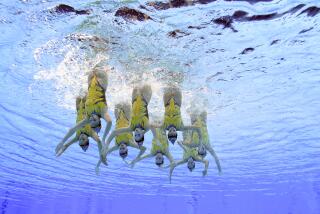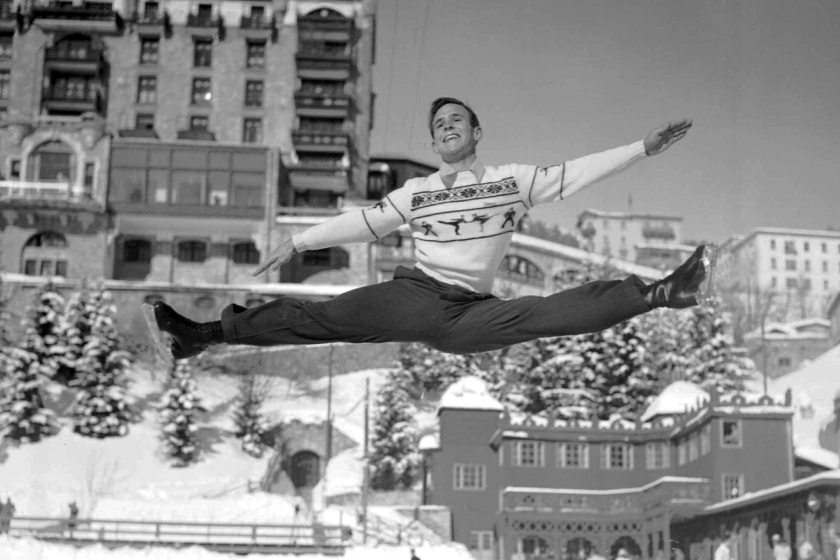Her Unheated 40 Feet
- Share via
The pool looks different to her, not just 40 feet of plaster and tile, an old diving board, patio chairs on the deck. As her mind drifts, physical barriers fade. She is carried across the backyard on currents that run the Antarctic.
Five strokes, six at most, to the deep end. She swims and swims, perhaps remembering other place she has swum, those icy polar waters that would have killed most people within minutes, a Mediterranean gulf or the Cape of Good Hope. Easier than keeping track. This is lap 300. “You could go nuts,” she says.
Five strokes back to the shallow end. Turn. Repeat.
This is clearly abnormal behavior for the suburbs, where pools are meant for barbecues, dangling your feet in the water on hot afternoons, playing Marco Polo with the kids.
Lynne Cox has been anything but normal for quite some time. “To float and look at the sky, it’s hard,” she says. “If I get in the water, I’ve got to start working.”
When Cox was a girl, her family lived in New Hampshire, where winter swimming meant swimming indoors at the YWCA. The moment she stepped outside, damp hair froze to her head. California was a paradise, a two-story stucco in Los Alamitos, where a 12-year-old could wriggle into her suit, dash out the back door, jump in the water. It was here, in the house where she still lives, that the idiosyncrasies became evident.
Her body did not grow lithe, like those of Olympic swimmers, but rounded and sturdy. A layer of fat, almost perfectly distributed like an internal wet suit, made her ride higher in the water, kept her warm. Early on, a swimming coach noticed that the longer she swam, the faster she went, and encouraged her to try open-water swimming. The teenager began acclimating herself to the cold, wearing light clothes, sleeping with the window open and without a blanket, her thoughts turning to the ocean.
At 14 years old, Cox swam 27 miles to Catalina and was hooked. Thus began a celebrated life in open water, three decades marked by swims across the English Channel and Strait of Magellan, the Gulf of Aqaba and Bering Strait. A few years ago, the Antarctic caught her fancy with its brash ice and salt water that runs near freezing, and that particular swim inspired the title of her recent autobiography, “Swimming to Antarctica” (Knopf).
Training for Antarctica would not be like training for any other swim. Like a seal, she put on extra weight for insulation. Like a penguin, which traps air between its feathers, she grew long hair to pile under her swim cap. She turned to her parents’ suburban home and the small pool whose heater had broken down years before, no one bothering to fix it.
“Fifty degrees in fresh water feels colder than 50 degrees in salt water,” she says. “For Antarctica, I did a lot of training in the backyard.” But there were other reasons as well.
Catch. Pull. Push.
A swimmer does not simply thrash at the water. The skillful arm moves in an “S” motion, the position of the hand changing subtly, searching for resistance. “You need to feel the water,” Cox says. “Hold onto it.”
But for the frigid waters off Antarctica, Cox used a stroke she had learned as a water polo player. In her 40-foot backyard rectangle, she practiced swimming with her head out of the water, to keep heat from escaping her head. She dissected her stroke into segments, focused on one at a time, the sculling of cupped fingers.
It was like moving in slow motion. Which meant she did not need to make as many turns.
Minutes passed, became an hour, this woman swimming oddly, insistently, surrounded by flower beds and cinderblock walls, a few palm trees. There is a spot on the exterior of the house, beside the back door, where the family dog scratches himself, the stucco worn smooth. Cox, though, was thinking of weather patterns off the Antarctic Peninsula. Erratic tides.
The Antarctica swim took place in December 2002, roughly a mile from boat to shore, her final stretch accompanied by curious penguins. Now Cox is taking a break, her reputation as a distance swimmer assured, nothing in mind for the next big challenge. At 47, she says, “I do occasionally get in with friends and play in the pool. Or sit and just look at the water.”
Maybe now the backyard pool just looks like a backyard pool. She tells a story about a neighborhood girl who came over to help with gardening. At some point, the girl wandered over to the water.
“I can’t swim,” she said. “My friend can swim, but I can’t.”
They sat on the edge for a while, getting their feet wet, the surface fidgeting and chlorinated blue. Even on the warmest afternoons, there is a coolness to the sound of splashing. Easing onto the first step. Down to the second. The third. Eventually they stood waist-deep, fully clothed. Cox showed the girl how to bend down, put her face in the water, blow bubbles.
More to Read
Go beyond the scoreboard
Get the latest on L.A.'s teams in the daily Sports Report newsletter.
You may occasionally receive promotional content from the Los Angeles Times.







